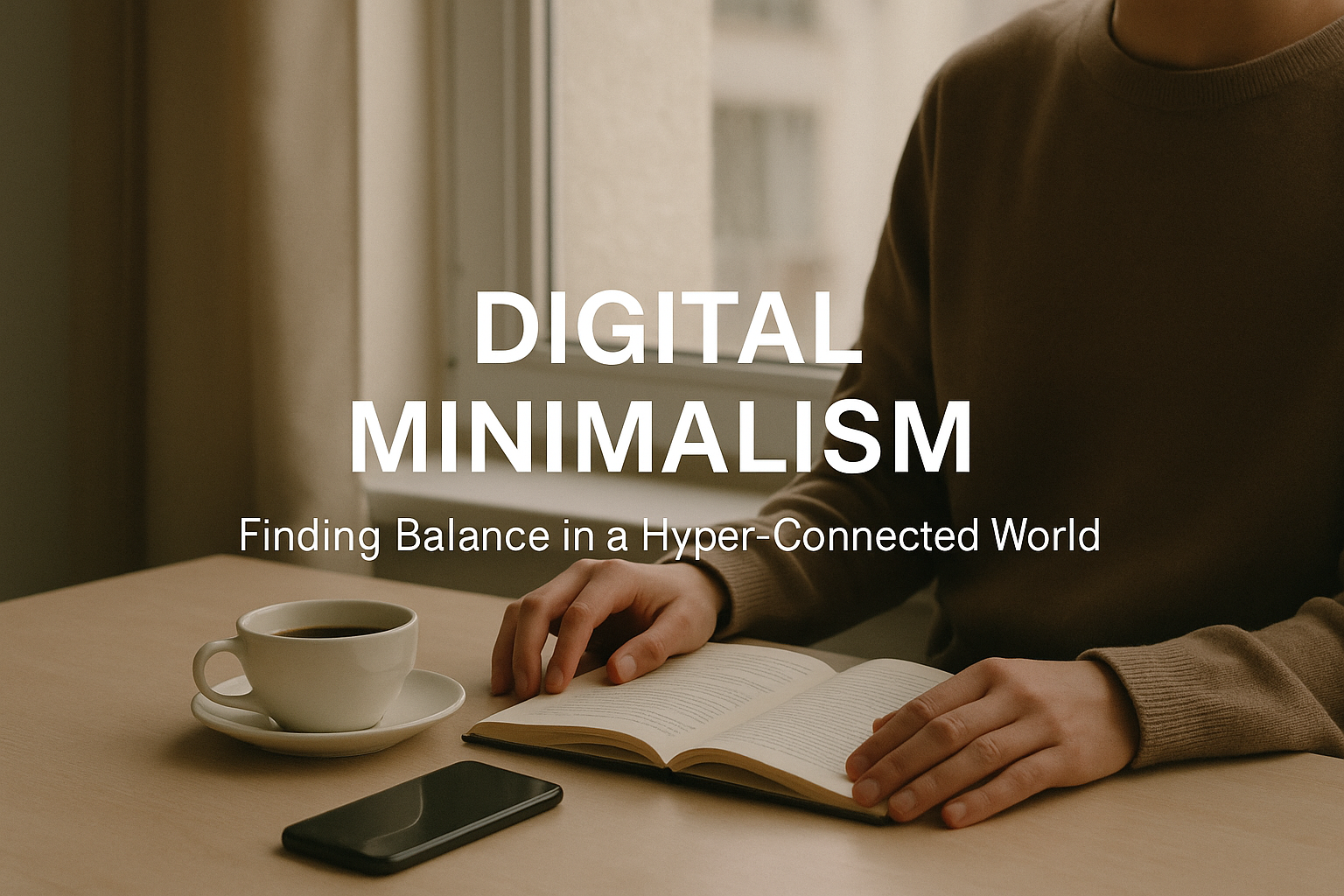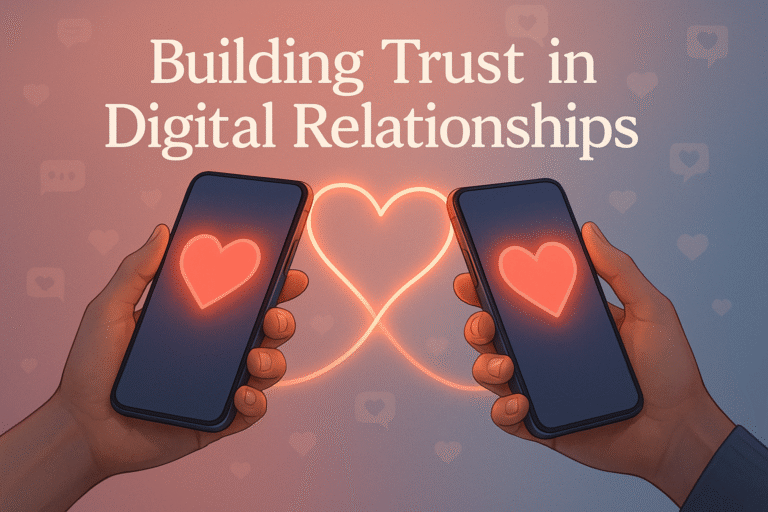
In today’s fast-paced digital world, staying connected feels essential — yet it often leaves us drained and distracted. Notifications, scrolling, emails, and endless online noise consume more attention than ever before. Digital minimalism offers a path back to balance — a philosophy that encourages intentional technology use instead of constant digital overload.
What Is Digital Minimalism?
Coined by author Cal Newport, digital minimalism is the art of using technology purposefully. It’s not about quitting the internet or deleting every app; it’s about aligning your tech habits with your values. Every tap, scroll, or click should serve a meaningful purpose — not just fill silence or boredom.
Why Digital Minimalism Matters Now More Than Ever
The average person checks their phone over 150 times per day. Notifications trigger dopamine, making us crave more digital interaction — even when it offers no real benefit. Over time, this leads to mental fatigue, anxiety, and loss of focus. Practicing digital minimalism restores control over your time and attention, allowing you to live with greater clarity.
1. The Psychology of Digital Overload
Our brains aren’t designed to process constant streams of data. Each alert or message triggers a micro-stress response. Over time, this constant stimulation creates a sense of urgency even when nothing important is happening. By reducing digital clutter, we give our minds the space to think deeply again.
- Information anxiety: Fear of missing out on updates or trends.
- Attention fragmentation: Constantly switching between apps reduces focus.
- Comparison effect: Social media highlights make users feel inadequate.
2. Recognizing the Signs of Digital Overuse
Ask yourself — do you reach for your phone first thing in the morning? Do you scroll aimlessly while eating or before sleeping? These habits signal dependency, not utility. A simple awareness of your digital triggers is the first step to freedom.
3. Start With a Digital Detox
A digital detox isn’t about cutting off technology forever. It’s about resetting your relationship with it. Choose a weekend or a few hours daily where you disconnect completely — no screens, no social media, no notifications. The silence will feel strange at first, then peaceful.
4. Curate Your Digital Environment
Just like decluttering a room, declutter your digital life:
- Unfollow accounts that don’t add value.
- Turn off non-essential notifications.
- Delete unused apps and bookmarks.
- Organize digital files into simple, clean folders.
5. The Joy of Doing One Thing at a Time
Multitasking is a myth. Studies show it reduces productivity by up to 40%. Digital minimalism encourages single-tasking — focusing on one thing with full attention. You’ll finish tasks faster and feel more satisfied.
6. Redefine Productivity
Modern culture equates busyness with success. But constant activity isn’t true productivity. Real progress comes from deliberate focus and rest. Use tools like Pomodoro timers or screen-time trackers to manage your energy, not just your minutes.
7. Schedule “Offline Hours”
Set tech-free zones and hours in your day — especially during meals, family time, or before bed. Keep your phone away from the bedroom to improve sleep quality. Offline hours help you reconnect with the physical world and strengthen real relationships.
8. The Value of Boredom
In a world where every spare second is filled by screens, boredom feels uncomfortable. But boredom is the birthplace of creativity. Allowing your mind to wander without distraction boosts problem-solving and imagination. Embrace quiet moments instead of filling them instantly with scrolling.
9. Rethinking Social Media
Social media connects, informs, and entertains — but also manipulates attention. Ask yourself: Is this app helping or draining me? Follow creators who inspire, educate, or bring joy. Unfollow negativity, limit daily use, and remember — social media should serve you, not the other way around.
10. Mindful Technology Use at Work
At work, digital noise often reduces efficiency. Constant email checks and message pings interrupt deep work. Try batching communication — check emails at fixed times. Use “Do Not Disturb” mode during focus sessions. Productivity increases when distractions decrease.
11. Reconnect With the Physical World
Replace screen time with tangible experiences — read printed books, go for a walk, cook, write, garden, or meditate. The physical world engages senses differently, grounding you in the present moment.
12. Relationships in the Age of Connectivity
Digital minimalism improves relationships. Being fully present — without glancing at your phone mid-conversation — builds trust and intimacy. A simple rule: when talking to people, look at them, not the screen.
13. Building a Healthy Tech Routine
Consistency matters more than strict rules. Create gentle digital boundaries:
- No screens during the first and last 30 minutes of the day.
- Weekly “offline Sunday.”
- Notifications only from essential apps.
- Separate work and personal devices if possible.
14. Tools That Support Digital Minimalism
Ironically, technology can help you use less of it. Try apps that limit usage or encourage focus:
- Forest: Stay focused by growing virtual trees.
- Freedom: Block distracting sites temporarily.
- RescueTime: Track where your hours really go.
- Calm: Practice mindfulness and guided meditation.
15. Designing a Minimal Digital Workspace
A clutter-free digital space reduces stress. Keep your desktop clean, use minimal icons, and set calming wallpapers. Fewer visual distractions translate to higher clarity and peace of mind.
16. Digital Minimalism for Mental Health
Constant connectivity increases anxiety and comparison stress. Reducing exposure to negative online content improves mood, focus, and confidence. Many therapists now recommend screen-time boundaries as part of holistic well-being.
17. The Financial Angle of Minimalism
Fewer subscriptions, less impulse buying, and more conscious consumption lead to better savings. When you pause before every digital purchase, you naturally make wiser financial decisions.
18. Raising Digitally Mindful Kids
Children imitate adults’ tech habits. Model healthy behavior by limiting your own screen use. Encourage outdoor play, creativity, and physical books. Teach them that technology is a tool — not entertainment by default.
19. Digital Minimalism in Business
Companies that embrace simplicity thrive. Streamlined software stacks, reduced emails, and clear communication save time and energy. Businesses that focus on essential tools foster happier, more efficient teams.
20. How to Start Your Digital Minimalism Journey
Begin small — one step at a time:
- Track your screen time for a week.
- Identify top distractions.
- Delete one unneeded app every day.
- Replace digital breaks with real-world actions.
21. The Minimalist Mindset Beyond Technology
Digital minimalism often inspires broader lifestyle changes. You begin valuing quality over quantity — in possessions, relationships, and experiences. The less clutter, the more clarity you create in every area of life.
22. Common Myths About Digital Minimalism
- Myth 1: It’s only for tech experts — anyone can do it.
- Myth 2: It means deleting everything — it’s about intentional use, not abstinence.
- Myth 3: It kills productivity — it actually enhances it by removing noise.
23. Measuring Progress
Track your emotional state, productivity, and free time weekly. Are you calmer? Reading more? Sleeping better? These signs show your digital minimalism efforts are working.
24. The Long-Term Benefits
- Improved mental clarity
- Stronger relationships
- Better sleep
- Higher focus and creativity
- Balanced emotional health
25. Final Thoughts
Digital minimalism isn’t about rejecting technology — it’s about reclaiming control. Every time you choose presence over distraction, you move closer to peace and purpose. Be mindful, intentional, and aware — your digital life should serve your real one, not replace it.
FAQs
1. How do I start digital minimalism?
Begin by tracking screen time, setting app limits, and identifying unnecessary digital clutter. Start small and stay consistent.
2. Can I practice minimalism without deleting social media?
Yes. Limit time, follow meaningful accounts, and disable unnecessary notifications instead of complete deletion.
3. How long should a digital detox last?
Even 24 hours can reset your mind. Ideally, schedule a full digital detox day once a week.
4. What’s the link between digital minimalism and happiness?
Less screen time leads to fewer distractions, reduced anxiety, and stronger real-life connections — all key components of lasting happiness.
5. Is digital minimalism suitable for professionals?
Absolutely. It enhances productivity, focus, and work-life balance, especially for remote workers and entrepreneurs.



